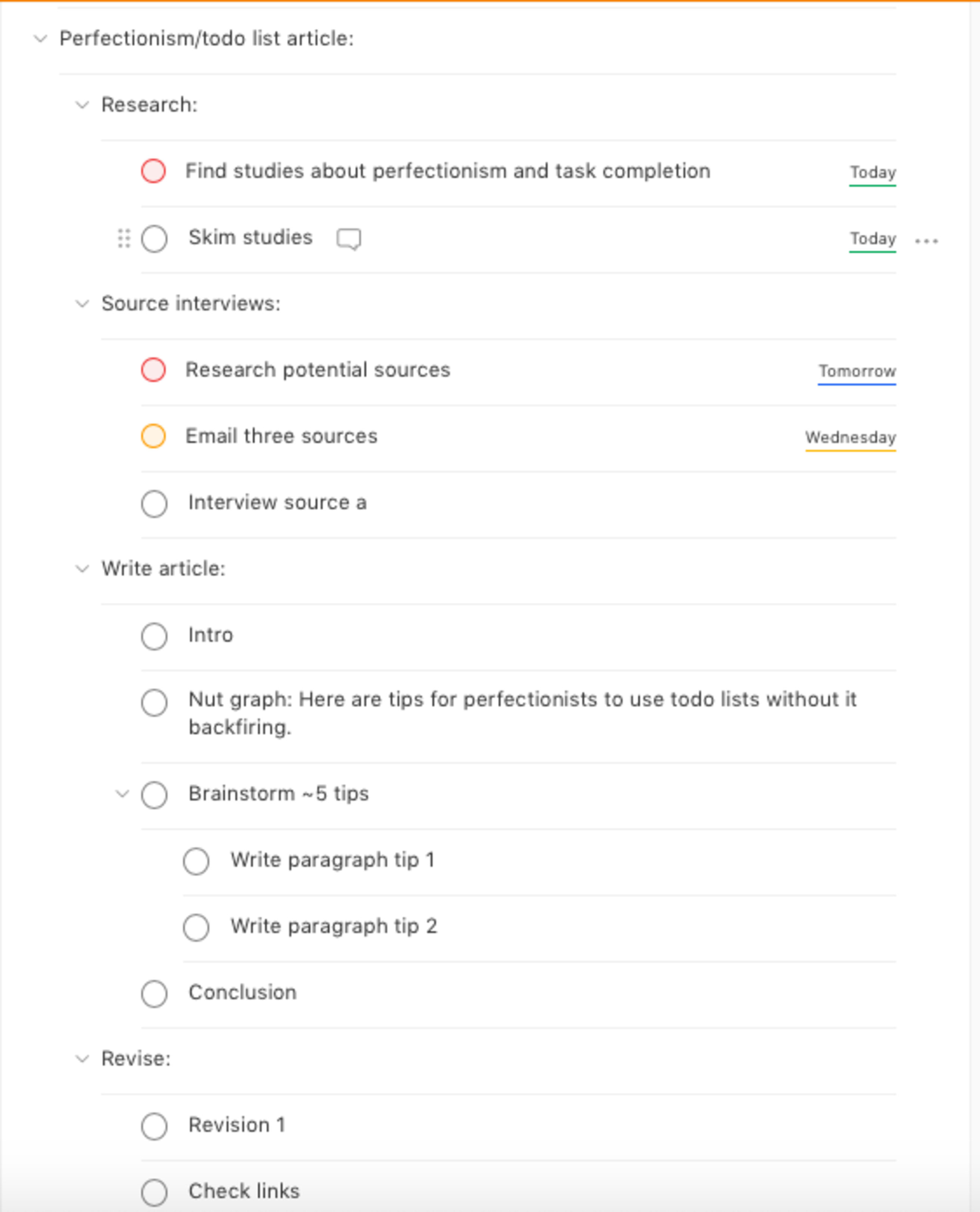Perfectionism has, time and again, undermined my efforts to achieve what’s most important to me. Until recently, I put off pursuing what I longed to do — exploring a career change and moving abroad — because I imagined all of the ways I might fail or be disappointed.
After spending time understanding where my perfectionism came from (in my case growing up in a competitive environment and having a naturally anxious personality), I realized I needed to take practical steps to push past it. That’s when I became an unlikely to-do list convert.
I once thought that reducing a big, hairy, audacious goal to a few mundane line items took the soul out of it. But without a concrete roadmap, I procrastinated, unable to conceive how I could work up to my ideal outcome.
I started to come around when my editor here at Doist gave me a Todoist account. Rather than simply allowing me to add and check off some bullets like other apps I’d tried — and quickly abandoned — Todoist’s feature set gave me unexpectedly tangible ways to keep me grounded in the task at hand rather than drowning in a sea of my own expectations.
Psychologists confirm that to-do lists can help perfectionists move past our paralysis. "Perfectionistic people may very well find making a list to be a reassuring guide to their day,” says Dr. Thomas S. Greenspon, a psychologist and author of Moving Past Perfect: How Perfectionism May Be Holding Back Your Kids (and You!) and What You Can Do About It.
But there’s also a big caveat: to-do lists can backfire if they become yet another report card we perfectionists use to evaluate ourselves too harshly.
“If a to-do list has too much on it, or things that are too vague or time-consuming to complete, it can be experienced as a constant reminder of failure,” says Dr. Roz Shafran, a professor in psychology at University College London.
To-do lists are also in no way a substitute for getting counseling or other kinds of help to deal with perfectionism. But, combined with awareness of the condition, the following are several effective ways to use to-do lists to overcome perfectionism paralysis.
1. Break down projects into concrete tasks
It’s admittedly one of the most common pieces of productivity advice, but this one is especially important for perfectionists: break down projects into manageable tasks. For some people, it helps to break projects into time increments (more on that in a bit), and for others, into steps. Either way, you’re armed with a set of discrete actions to take rather than a big, vague cloud of high expectation hanging over your head.
For example, I dreaded (even more than usual) doing my taxes this year because I had moved between states and abroad and earned many different types of income from being a full-time employee, freelancer, and a part-time employee.
I finally decided to create a project in Todoist and sub-tasks for every kind of form I needed to obtain and step I had to take to get it. To my own surprise, breaking the larger project down like this helped me file almost a month before the deadline — after initially planning to file for an extension. Plus, I felt a kind of nerdy satisfaction checking off each task one-by-one. In the end, a project I had hyped up to be daunting wasn’t that bad.

The main steps of my to-do list for this article
2. Define the next action in a project rather than all subsequent steps
For perfectionists, there’s a risk that a to-do list may “become unwieldy and overwhelming, and reflect a perfectionistic version of each task that's over the top compared to what's actually necessary and realistic,” says Dr. Alice Boyes, author of The Healthy Mind Toolkit and The Anxiety Toolkit. “For instance, the person will plan to make and update daily a 10 column spreadsheet when really a three column spreadsheet updated weekly would do.”
To head this off, she suggests defining the next immediate step for each project and no more. "For example, if the task is fixing a broken drawer, the next action might be to ‘buy super glue from dollar store,’” she says.
When I start out planning lessons and have no idea what I’m going to do (this past year, I’ve taught English as a foreign language), I begin by simply adding an item like “Plan food vocabulary lesson.” As I gain a better sense of what I’ll want to do after researching online, I’ll start to add more specific items like “find video about food in the U.S” and “print out flashcard images,” “laminate flashcards,” etc.
Focusing only on the next action gives me permission to work on something even if I don’t have it all figured out—which has been crucial to completing tasks that in the past have left me paralyzed.
3. Set priorities by designating A, B, C, and F Tasks
Perfectionistic tendencies are often ingrained early in school, where we learn that our future success depends on earning excellent grades. I absorbed the idea that straight As were necessary for success and to get them in my competitive school system, I had to always go above and beyond.
But as an adult where an “A-performance” is a constantly moving bar, I quickly learned that putting “A-effort” into everything is a recipe for burnout.
“[T]rying to do everything well—and exerting the same level of detail, effort, and energy to all your endeavors—leaves you feeling stressed and exhausted all of the time, and as though you never get to work on what is most meaningful to you,” says Dr. Jeff Szymanski, a clinical psychologist and author of The Perfectionist’s Handbook.
To help you prioritize various aspects of your job, Szymanski recommends stepping back and asking yourself a bigger question: “What do I want my life to stand for?” Then, identify your “A tasks”, the three work skills and tasks at which you would most like to excel, and write them down. Follow that by identifying your B tasks: those at which you can give 80 percent, your C tasks: “tasks that essentially no one, including you, sees or regards as significant” and which you can be average at, and finally F tasks: “tasks that have become time-consuming but that, in reality, don't matter.”
On a day-to-day level, you can use Todoist to set priorities to tasks that align with your big-picture goals:
Priority 1 = Your A tasks. These are what you’ll give most of your time and energy to. Work on these during the time of day when you have the most energy and focus. For many people, that will be first thing in the morning.
Priority 2 = Your B tasks. Leave these tasks for lower energy times of day or batch them together on a particular day later in the week that tends to be less productive for you anyway. If you’re having problems getting started on your A tasks, you may want to start with a B task for a quick win to build momentum heading into the day.
Priority 3 = Your C tasks. These are tasks that you’ll want to give the least of your energy to, saving for a particular time once a week or every two weeks. Some of them may be intellectually less demanding than your A or B tasks and therefore tempting to complete first, but spending too much time on them can take you away from what really matters.
Priority 4 = Your F tasks. Try to delegate or automate these tasks as much as possible. If you must still do them, set a strict time limit so you aren’t tempted to give A+ time and attention to tasks that don’t ultimately matter.
You can even create new Todoist filters like “Today’s A Tasks” so you only see the A tasks that you want to work on for that day. Just use the filter query “today & p1” to pull up the tasks due today that you’ve marked as priority 1. You can even pin your A tasks view to the top of your Todoist menu as a visible reminder of your priorities.
Then create corresponding filters for your B, C, and F tasks. Having to physically switch between task views will remind you which “mode” you’re working in and help you switch out of a constant A mindset.
4. Set a realistic schedule and track your time
Often, perfectionists bite off more than we can chew — one consequence of not prioritizing. We then expect ourselves to accomplish an unrealistic amount in our available time. When we don’t meet these impossible goals, we feel like we’ve failed, and feeling like a failure makes it hard for us to get motivated. It’s a vicious cycle.
Experts recommend assigning your tasks a time limit to force yourself to not get lost in perfecting each and every detail. Bring awareness to how you use your time and “look for where perfectionism might be creating problems/imbalances,” says Dr. Boyes.
There are several strategies you can use to become more mindful of the time you spend on tasks:
Install an app like Rescue Time that works in the background to automatically track how you spend your time on your computer.
With Todoist’s Toggl integration, you can track the time you spend on each of your tasks through Todoist and get a detailed breakdown in Toggl.
With the very popular Pomodoro productivity method, you break down your work into 25 minute intervals and take regular breaks. You can set up a Pomodoro system in Todoist by estimating how long a task takes and breaking it up into Pomodoro-size sub-tasks.
Use the Todoist Google Calendar integration to visualize your tasks in your calendar and block out specific time slots for each one.
Simply add a time limit behind each task title — for example: “Revise 2nd draft (1 hour)” — or add a time limit label to each task, for example: type “@1_hour” after the task title. As you work through your to-do list each day, you’ll have a visual reminder of how much time you’ve allotted for each task.
While I don’t use a time tracking method, I find that managing my to-do list helps me moderate overcommitting by having a visual reminder of what I’ve set out to do rather than keeping it all in my mind.
5. Focus on process goals rather than outcome goals
Perfectionists often become so focused on the end result of a project that we don’t appreciate and enjoy (or ever really get started on) the process. Too often, we miss out on the satisfaction of small wins that keeps us intrinsically motivated.
When set up right, a to-do list can help you focus on the process – actions you mostly have control over – rather than obsess over future outcomes – results that are largely outside of your control. Set up your projects to include mostly “process goals” as opposed to “outcome goals”. For example, writer and entrepreneur James Clear was able to create a wildly successful blog by following the process goal of publishing a new article every Monday and Thursday for three years.
“Imagine if I had set a deadline for myself instead, like ‘get 1,000 subscribers in 12 weeks.’ There's no way I would have written every Monday and Thursday and if I didn't reach my goal, then I would have felt like a failure.” he says.
“A better way to achieve your goals is to set a schedule to operate by rather than a deadline to perform by.”
Reframing success around the process of actually publishing rather than the outcome of shares or views has been a critical change in mentality for me.
6. Start fresh every day
A to-do list is not a report card but rather a work-in-progress. It’s okay and totally normal if you don’t complete everything you’d hoped. We tend to psychologically overestimate what we can do in a given day and then feel bad when we haven’t achieved a measure that was actually impossible.
Indeed, a large number of Todoist users let their tasks “snowball,” so that their unaccomplished tasks start to accumulate in the “overdue” section. Their to-do list is no longer a tool to help manage and control projects but a reminder of everything they haven’t done. This is a particularly stressful frame-of-mind for a perfectionist.
Make it a ritual before leaving work for the day to open your Next 7 Days view and drag and drop any leftover tasks due Today to later in the week, or even in the next week. Instead of feeling guilty and overwhelmed by everything you didn’t accomplish, you’ll end every day at “Todoist Zero” with a reliable plan for how and when you’ll complete your tasks.
7. Get help
When you’re a perfectionist, there’s always a risk of overdoing even the best-intentioned self-help strategies.
“Perfectionism presents a paradox: If you suggest something which might be helpful for my perfectionism, I might very well get bogged down on the issue of whether I am following your suggestion correctly. So, if to-do lists turn out to be helpful, that’s terrific,” but if it “doesn’t turn out to be helpful in a sustained way,” Greenspon advises seeking therapy.
“[T]alk with someone about where all of the anxiety and concern about being perfect comes from in the first place!” he says.
Dealing with my perfectionism has been a journey that continues. Through therapy, reading (extensively) about perfectionism, and journaling, I’ve come to recognize a self-critical voice that I once thought was helping me but in truth was undermining my goals. My decision of the last year to leave my job, start freelancing, and move abroad came about once I started to let go of the need for assured success and understand that there was a lot that I couldn’t know and couldn’t control.
My life — and my to-do list — is not something I can plot out to perfection in advance but rather something I’ll be constantly rewriting. Recognizing that fact is what finally allowed me to let go of my impossibly high expectations for myself and instead do my best to enjoy the inevitably imperfect journey along the way.

